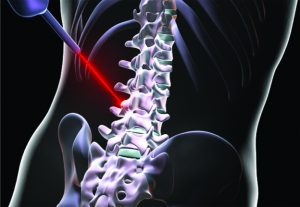By Lam Nguyen, MD, Orthopedic Surgeon
 As a spine surgeon, my patients often ask me if their spine surgery can be done with a laser. There is a perception by the general population that laser technology is modern and futuristic, and therefore offers cutting edge treatment and better outcomes. However, the reality is that lasers have been around for decades and are almost completely useless when it comes to spine surgery.
As a spine surgeon, my patients often ask me if their spine surgery can be done with a laser. There is a perception by the general population that laser technology is modern and futuristic, and therefore offers cutting edge treatment and better outcomes. However, the reality is that lasers have been around for decades and are almost completely useless when it comes to spine surgery.
What the general public does not realize is that laser surgery for spinal conditions isn’t even taught in most, if any, spine surgery fellowship training centers in the US. That is because lasers have a very limited role in spine surgery. At major academic national and international spine surgery meetings and in the major spine surgery journals, there is a paucity (if any) of peer-reviewed high quality discussion and publication supporting the use of lasers in spine surgery.
At first glance, it appears as though laser surgery is the safer and more effective option than traditional surgery. Laser spine surgery is often promoted as being minimally or even noninvasive and risk-free, with bold promises of complete pain relief within hours or days. However, these laser spine procedures can result in disastrous complications. Lasers obliterate tissue with intense heat and sometimes gas production (due to the boiling of water molecules). This heat can be transmitted to adjacent anatomical structures and can cause serious damage to the nearby nerves. Another reason a laser is not commonly used for spine surgery is because a laser is a straight beam of light that is ill suited for removing lesions hiding around corners that compress the nerves. The ability to navigate angles safely and to reach around tight corners to completely free up the nerves in the spinal canal is an important feature and a major advantage for using traditional microsurgical tools with traditional open surgery. It is not an uncommon occurrence that I see patients in clinic who have had “laser surgery” who present to me for persistent or worsening symptoms due to incomplete or inadequate decompression of their nerves.
I have also had patients who had undergone “laser surgery” told me that their surgery was a success. They show me the 1 to 2 inch incision in their back and claim that the smaller incision made possible by the “laser surgery” resulted in much less pain and allowed them to recover much more quickly. I explained to these patients that what they likely had performed was minimally invasive surgery rather than laser surgery. In the traditional open approach to spinal surgery, the surgeon makes an incision in the skin and dissects through muscles to get to the spine. Because of the muscle dissection and stripping involved, this can result in more blood loss, postoperative pain, and longer recovery. An alternative to the “traditional open” surgery is “minimally invasive surgery” or MIS surgery. With MIS surgery, the surgeon makes a much smaller incision (usually 1-2 inches) and uses special tools, such as a tube retractor to split the muscle fibers in order to get down to the spine. Because the muscles are split through their natural planes instead of being dissected or stripped off, there’s much less blood loss and pain, and faster recovery.
More recently, due to clever, and arguably misguiding, advertisement pitches made by certain medical practices/groups, the general public has erroneously equated minimally invasive surgery to laser surgery. A laser may or may not be used during a MIS surgery. In fact, the vast majority of minimally invasive spine procedures in the U.S. are done without a laser. If a laser is used at all during a MIS surgery, its use is limited to remove the soft tissues over the spine. The main goals of the surgery are still being accomplished by using traditional instruments to remove the bone, ligament, and disc materials in order to free the nerves. The laser in “laser spine surgery” actually plays a very minor role, or in most cases no role at all. If your surgeon claims that he/she uses a laser during surgery, be sure to ask what they mean by “laser” and what is being achieved by the “laser” during the surgery. There are surgeons who perform radiofrequency ablation for facet disease (a procedure commonly performed by pain management physicians to burn off the nerves around the facet joints that have developed arthritis) in conjunction with a minimally invasive surgery done for pinched nerves. However, these surgeons will refer to the radiofrequency portion of the case as “laser surgery” to give themselves a marketing competitive edge. Be ware of these misguiding claims.
There is no magic bullet or miracle treatment for most spinal conditions. Laser spine surgery or even minimally invasive surgery may not be appropriate for most patients. For example, for patients with back and leg pain from spinal deformity (scoliosis) or instability (slipped vertebra), if all the spine surgeon uses is a laser, then the bigger problem is missed. A master spine surgeon truly understands that more complicated spinal problems often require traditional open surgery for the best outcomes. Before you choose to have laser spine surgery or pursue minimally invasive spinal procedures, be sure that you obtain more than one opinion from a fellowship-trained orthopedic or neurosurgical spine surgeon. Your spine surgeon should choose the best surgical approach for you based on your particular spinal pathology and anatomy. The bottom line is that most spine surgeons do not use or recommend the utilization of lasers for spine surgery because there are no clear benefits. On the contrary, there is an abundance of high quality research studies proving the effectiveness of traditional open and more modern minimally invasive spine surgery techniques.
For more information on their services and organization, please visit their website at www.Kwoc.net.
941-893-6447








